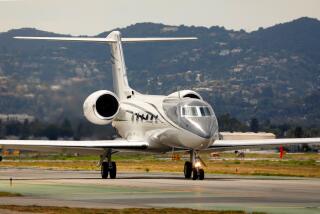Reluctant to Be Rescued : Despite Huge Losses, Airlines Worry About New Government Activism
- Share via
Northwest Airlines took no chances when upstart Reno Air decided to begin flying to the giant carrier’s hometown of Minneapolis in April.
After Reno announced plans for service between Reno and Minneapolis, Northwest fought back by cutting fares and proposing new flights from Reno to Minneapolis, Los Angeles, San Diego and Seattle.
Unexpectedly, however, the lopsided battle between the nation’s fifth-largest airline and the tiny newcomer drew the attention of the Clinton Administration. Responding to Reno’s complaints, Transportation Secretary Federico Pena told Northwest President John Dasburg that he wanted the airline to change what was viewed as anti-competitive behavior.
Northwest soon dropped West Coast service from Reno.
The incident, which surprised the airline industry, marked a dramatic departure from the hands-off approach practiced by the Reagan and Bush administrations toward airline competition.
But the Clinton team might be in for some surprises of its own as it pursues an activist role in the aviation industry. While hailed as long overdue by some, charting a more aggressive aviation policy could backfire in a troubled industry where many players resent the return of the government spotlight.
“We have not yet seen government come forth to help us,” said Barbara Beyer, president of Avmark, a Washington-based aviation consulting firm. “I’m seriously concerned that the Administration is going to do more harm than good.”
Such concerns have not cooled government interest in the industry, which President Clinton views as playing a crucial role in the nation’s future prosperity.
During the last 2 1/2 years, U.S. airlines have suffered more than $10 billion in combined losses in the wake of the recession and Gulf War. Meanwhile, the airlines’ problems have spilled over into the commercial aerospace industry, which has seen billions of dollars in aircraft orders lost or postponed. Boeing and McDonnell Douglas have laid off thousands, and further cutbacks are likely.
But instead of letting airlines work out their own problems, as American Airlines Chairman Robert Crandall and others have advocated, Clinton stepped in quickly on taking office. He backed the formation of a blue-ribbon commission, which began meeting last month, to look at the industry’s problems and suggest solutions.
Many policy conflicts await the National Commission to Ensure a Strong Competitive Airline Industry, whose 15 voting members have 90 days to come up with suggestions. Some consumer and labor groups, as well as members of Congress, have called for a return of some form of government regulation. Imposing a government-mandated floor on fares would prohibit costly price wars and help airline profits, while a price ceiling would protect consumers from gouging, supporters argue.
But critics say consumers more than likely would suffer under government-imposed price regulation.
“I don’t think travelers would welcome a system in which there are no more fare wars,” said Irwin M. Stelzer, director of regulatory policy studies at the American Enterprise Institute. “What (Clinton) will find is he has a choice between shareholders and travelers.”
Commission members and policy planners must also navigate through the many rifts that divide the airlines themselves. There is widespread disagreement about allowing foreign carriers to buy into domestic airlines or limiting the time an airline can operate under bankruptcy protection.
In testimony before the commission last week, Crandall of American Airlines blamed bankrupt carriers for much of the industry’s ills. However, Robert Ferguson, president of Continental Airlines, which has recently emerged from its second stay in Bankruptcy Court, blamed the huge expansion of mega-carriers such as American for creating a glut of airplane seats and depressing prices.
Even if the Clinton Administration chose to steer clear of the airline industry--as many airline executives and analysts have advised--there would be a price to pay, transportation specialist Harold Sirkin said.
“You can wait and let the industry shed jobs over the next couple of years to solve its problems,” said Sirkin, who follows airline issues at the Boston Consulting Group. “But is that all right or not from society’s standpoint?”
The Administration, however, has said it opposes the return of government regulation of the airline industry. In stepping between Northwest and Reno, Pena said he wanted to show that the Administration is serious about protecting and promoting competition.
Consumer advocates have for years criticized previous Administrations for failing to curb the power of the giant carriers--such as American, Delta and United--that have come to dominate the industry and, in their view, stifle competition and start-ups such as Reno.
While the rigorous enforcement of antitrust laws may lead to the creation of more airlines, it could also cost consumers money, say aviation analysts. A large airline that would have cut fares to compete against a newcomer may now hold back for fear of being sued for anti-competitive behavior.
“The person using antitrust laws might stop price competition that helps consumers,” said an aviation attorney. “It becomes a way of protecting someone who is just not a very good competitor.”
Using antitrust laws to protect a certain class of competitors--such as new carriers--”does not mean you will protect competition,” said Clifford Winston, a senior fellow at the Brookings Institution. “If they just want to keep airlines around, that could be quite inefficient.”
Newcomers such as Reno argue for an activist government role when it comes to enforcing antitrust laws.
“The government is the watchdog and should take an active stance in addressing issues like that,” said Jeffrey H. Erickson, Reno Air’s president and chief executive. “We weren’t sure they would.”
Times staff writer Jonathan Peterson contributed to this story.
Nose Dive
Over the last five years, the U.S. airline industry has gone from recording its largest one-year profit--$1.7 billion in 1988--to its largest loss, a $4-billion deficit in 1992.
In billions of dollars
1988: $1.7-billion profit
1992: $4-billion deficit
Source: Air Transport Assn.
More to Read
Inside the business of entertainment
The Wide Shot brings you news, analysis and insights on everything from streaming wars to production — and what it all means for the future.
You may occasionally receive promotional content from the Los Angeles Times.










